Master pharmacy app development with this concise guide. Unlock strategies, insights, and tips to build a successful online pharmacy app.
Today, eHealth encompasses a wide range of modalities that are embraced and actively utilized by the general public. EHR systems, telemedicine, the development of online pharmacy applications, AI-powered clinical decision support solutions, and even robotics are no longer regarded as peculiar, potentially hazardous, or untrustworthy. On the contrary, individuals are enthusiastically receptive to the notion of accessing comprehensive medical services without encountering the typical inconveniences. The increasing popularity of ePharmacy serves as a compelling testament to this fact.
The forthcoming editorial will examine the topic of pharmaceutical application development from both business and technical standpoints. It will provide readers with all the necessary information to transform a promising business concept into a fully operational and market-ready online pharmacy.
Business Benefits of Creating a Custom Online Pharmacy App
When considering healthcare, an aspiring entrepreneur looking to enter the market with a digital product has numerous options to choose from. However, it is worth considering the development of an online pharmacy app over other types of applications. This particular software offers several advantages that make it a favorable choice.
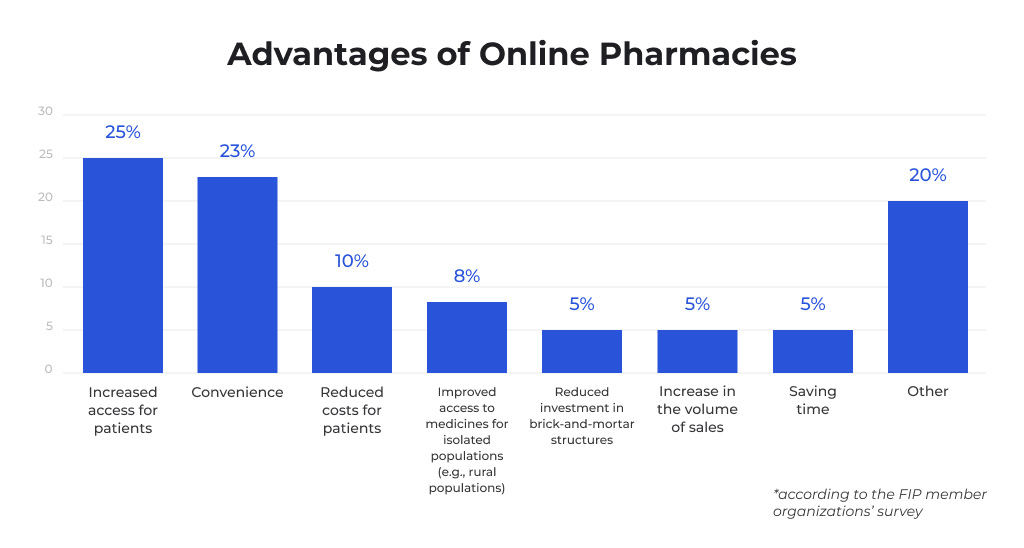
Bringing Actual Value
The 2021 Global Survey conducted by FIP revealed that online pharmacies offer two significant benefits that are highly valued by individuals: enhanced patient access and convenience. This convenience extends not only to patients but also to medical professionals.
Investing in pharma app development is highly recommended as it addresses a specific real-life issue, which is the accessibility of healthcare services. By making it easier for people to access these services, these apps have the potential to be widely adopted if developed effectively.
Loyal Audience
The aforementioned text can be rephrased as follows: Medical apps have a distinct advantage over gaming, entertainment, and educational apps in terms of user retention. While the latter are often replaced once the user loses interest or becomes too busy, medical apps tend to have a dedicated following.
Although finding an app that meets all the user’s requirements can be challenging, once they find the perfect match, it is likely to remain on their phone indefinitely. As a result, business owners can benefit from a loyal audience, which can lead to more effective advertising, stable revenue, higher profits, and greater opportunities for growth and expansion.
Efficiently Reducing Expenses and Enhancing Workflow
Developing an online pharmacy application is an efficient method to optimize management processes and workflow for pharmaceutical companies. By implementing a user-friendly app, employees can save time on manual tasks such as inventory updates, stock adjustments, and expiration date tracking. These tasks are automated and completed in a matter of seconds.
Furthermore, digitalization reduces the costs associated with paperwork and minimizes the risk of human error. These benefits align with the Healthcare Improvement Quadruple Aim model established by FIP.
Enhanced Marketing Prospects
One of the advantages of custom pharmacy app development is its flexibility. The business owner has the freedom to incorporate numerous unique and useful features without being constrained by a rigid framework.
While it is important to prioritize simplicity and a seamless user experience, it is undeniable that custom software offers greater marketing potential.
For instance, by integrating AI/ML algorithms into the app, the entrepreneur gains access to valuable insights and can thoroughly analyze customers’ behavioral patterns. Consequently, a sophisticated recommendation system can suggest complementary goods and services to visitors, such as tests, vitamins, and care products.
Easier Ways to Develop New Markets
Developing a new market can be challenging for a new player, especially when competing against well-established brick-and-mortar pharmacies in a specific area. However, going digital can be the key to success. By investing in high-quality online pharmacy app development, entrepreneurs can acquire a powerful tool that enables them to attract a larger audience that may not have been accessible geographically, socially, or economically. This investment can prove to be a one-time solution for expanding the business and reaching new heights.
Pharma App Development: A Promising Market Overview for 2023
In this section, we will delve into the current market situation and the future of online pharmacy app development. The eHealth industry has gained the trust of the audience relatively later compared to other digital business niches. It is important to note the longevity of e-commerce and the ongoing caution people have towards telemedicine. This caution stems from the fact that not only money, but also human lives are at stake.
Nevertheless, this does not imply that ePharmacy lacks promising prospects. In fact, a report by Fortune Business Insights predicts that the Global ePharmacy Market will surpass USD 177 billion by 2026.

Upon examining the aforementioned chart, it becomes apparent that the global market is experiencing a consistent upward trend. This indicates that the general public’s interest in and reliance on ePharmacy solutions is also on the rise. It is evident that individuals worldwide, regardless of their economic status, have come to recognize the safety, efficacy, and significance of online pharmacies.
Furthermore, the substantial number of monthly visits to the top five online pharmacies worldwide serves as a strong market indicator, suggesting that the development of online pharmacy applications has a promising future beyond 2023.
Additionally, it is important to take into account several other factors. Firstly, ePharmacy users generally report a higher level of satisfaction compared to individuals who opt for traditional brick-and-mortar medicine shopping. Secondly, individuals place great importance on maintaining their privacy when purchasing medications, and modern applications effectively address this concern. Lastly, in the event of another outbreak of COVID-19, online pharmacies are expected to experience a surge in popularity due to their ability to provide fast and contactless medication delivery during quarantine.
Types of Pharmacy Applications Available in the Market
After considering all advantages and disadvantages, if you have made the decision to explore pharmacy app development, the subsequent logical course of action is to thoroughly analyze the various types of applications available in the market. This will enable you to ascertain which one aligns with your business concept, vision, and expectations.
This editorial will discuss three fundamental categories of ePharmacy apps: aggregators, online stores, and chain apps.
Aggregators: Enhancing Data Collection and Analysis
This app is designed to be accessible to individuals who do not possess a pharmacy. It serves as a platform that brings together various pharmacies and vendors within a specific geographical region (such as a city, province, state, or country). Users are required to register and can then browse through a range of options, which may consist of products from different vendors. Once an order is placed, it is processed and delivered to the customer.
Essentially, the business owner benefits from establishing a digital platform that facilitates the connection between pharmaceutical vendors and customers.
Online Stores
This online pharmacy app development is beneficial for both established pharmaceutical businesses and startups. It indicates that the user either possesses an existing independent company or intends to establish one.
Online pharmaceutical stores enable self-sufficient businesses, such as pharmacies and medical companies, to sell their products online and directly engage with their target audience. Typically, this sales channel serves as a complement to physical store sales and serves as a means to reach a broader customer base.
Pharmacy Chain Applications
Custom pharmacy app development for existing chains facilitates resolving multiple challenges and eliminating specific bottlenecks that may appear during the management process. This includes IoT and smart device integration within the pharmacies, introduction of advanced analytical tools, and implementation of a modern inventory-tracking system.
WHO Classification
An alternative method, which may not be as widely adopted by business owners, involves the categorization of digital health interventions by the World Health Organization (WHO). This approach provides an additional means of classifying the various ways in which digital tools and technology can be utilized to meet the healthcare system’s requirements.
At present, the World Health Organization (WHO) employs a classification system that centers on the primary user of the digital solution. This classification comprises four categories.
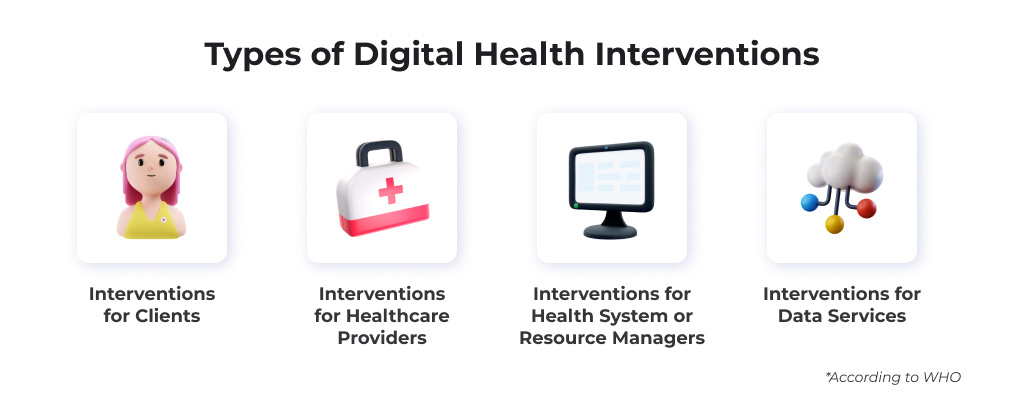
1. Interventions for clients: This category encompasses tools designed for individuals who receive healthcare services and their caregivers.
2. Interventions for healthcare providers: These are digital instruments intended for individuals who provide healthcare services.
3. Interventions for health system or resource managers: This category includes means to administer, manage, control, and supervise health systems.
4. Interventions for data services: These mechanisms support and simplify all data-related processes within the healthcare system, such as collection, management, processing, and exchange.
In terms of pharma app development, it can typically be classified as a digital intervention for clients since it caters to individuals who order medications and receive healthcare services. However, if an online pharmacy already exists and an application is needed for staff members, with a focus on inventory management, this app would no longer be considered an intervention for clients. Instead, it would be categorized as an intervention for healthcare providers.
Breaking Down the Process of Developing an Online Pharmacy App
This section will be useful for entrepreneurs seeking to acquaint themselves with the behind-the-scenes aspects of healthcare app development. Despite typically being the domain of the tech team, it is advantageous to have an understanding of the project’s progress and anticipate the next steps.
Essential Characteristics of a Pharmaceutical Application
When considering custom pharmacy app development, it is important to note that there are no limitations. Each solution is distinct, and the range of features certainly differs. Additionally, as you are already aware, various types of apps may necessitate significantly diverse features and content.
For instance, when developing software for patients/clients, it may incorporate features such as medication price comparison, suggestions for duplicate prescriptions, in-app payment options, and more. Conversely, if the software is intended for internal use only, the feature set may encompass prescription verification, payment and order tracking, order management, and additional functionalities.
Nevertheless, in order to ensure the universality of this editorial, the focus will primarily be on the essential functionalities required for any pharmaceutical application. The following features must not be overlooked during the development process, as neglecting them would jeopardize the quality of the final product.
Login and Registration
Regardless of the primary user, whether it be a patient, pharmacist, admin, or delivery man, it is essential to provide them with a means to access the app’s content and authenticate themselves each time. This necessitates the inclusion of a login and registration feature.
The specific type of login and the amount of information required for registration may vary depending on the user. However, the most commonly used option is a combination of a username and password. This combination can either remain the same for all user roles or be subject to change. For instance, customers may utilize their phone numbers and passwords received via SMS for logging in, while pharmacists may use their ID along with a prearranged complex password.
Notifications system
Timely updates are crucial for all users. The content of the notifications will vary based on user role. Customers should be notified about order status, medication availability, and marketing events. Couriers need alerts for new delivery requests and changes. Admins and pharmacists will have their own unique notifications. Including this feature is essential for your online pharmacy app development plan.
Search and Filtering
An extensive search and filtering system is crucial for any pharmaceutical application. However, the way users interact with it varies based on their roles. Customers utilize the system to search for required medications, while couriers and pharmacists use it to search for and organize orders. Administrators, on the other hand, rely on the system to search for and categorize orders, products, and users. Therefore, a pharmacy app development team must incorporate a comprehensive search and filtering system to meet the diverse needs of its users.
Dashboard/User Profile
It is essential for a good UI/UX design to ensure that every user has access to all the application’s functionalities. To achieve this, incorporating a dashboard or user profile is crucial. The objective is to provide swift and effortless access to all the features of the application, which may differ based on the user type, such as customer, courier, admin, or pharmacist.
Contact/Communication tool
Despite each user having their own apps or customized dashboards, they should all remain connected. This requires an easy-to-use communication tool, such as online chat.
Customers need to contact pharmacists for product-related questions. Pharmacists should be able to communicate with clients, couriers, and the admin for updates and support. Admins should gather and process requests from pharmacists and couriers. Delivery team members should stay in touch with clients, pharmacists, and admins.
The choice of communication tool is up to the business owner, but at least one tool should be included.
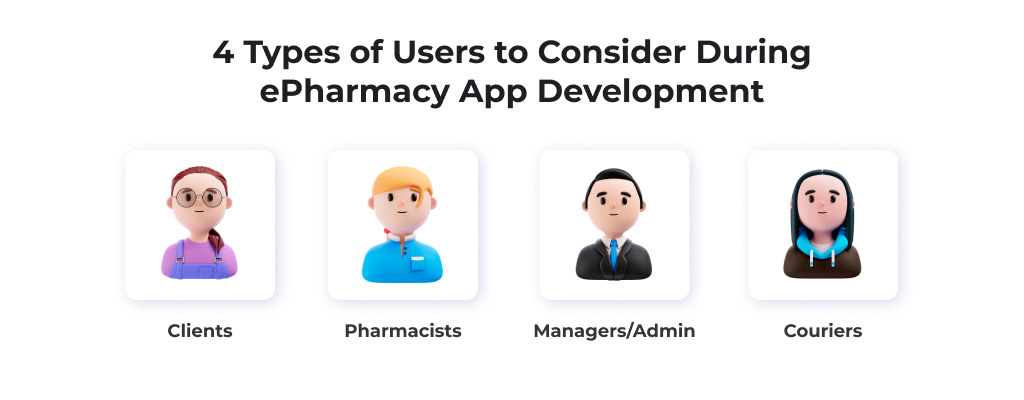
Different pharmaceutical apps may require additional essential features, which can be found in the table below.
| Type of application (by primary user) | |||
| Customer app | Pharmacist app | Admin app | Courier app |
| Meds comparison Dupe/substitute recommendation system Prescription upload and refill Online orders Payment gateway Order history and tracking Product return and/or replacement Comments | Prescription management Order management Order history Online billing Payments tracking Order dispatching Inventory management | User management Order management Analytics and reporting Price management Marketing tools (ads, promos, social media integration, etc.) Complaint management | Real-time navigation Delivery history Personal rating Order status management |
Selecting the Best Tech Stack for a Regret-Free Experience
It is beneficial for entrepreneurs to have a basic understanding of popular technologies, even if they are not tech experts. To simplify the process of pharmacy application development, we have compiled and categorized a list of tech tools.
- These tools include Python, Ruby on Rails, and PHP frameworks for back-end development, as well as HTML/CSS, JavaScript, TypeScript, Angular, and React.JS for front-end development.
- For mobile app development, we recommend React Native, Flutter, Swift, Kotlin, and Ionic.
- For search functionality, Elastic Search and Solr are useful tools.
- For push notifications, Firebase Cloud Messaging and Amazon Simple Notification Service are recommended.
- In terms of databases, MySQL, Dynamo, Maria, Mongo, and PostgreSQL are all viable options.
- Finally, for cloud services, we suggest AWS, Azure, and Google Cloud. For payment and order processing, Braintree, Stripe, Skrill, and Paypal are all reliable options.
The tech stack mentioned above is considered to be the most fundamental and does not encompass all the potential tools that can be utilized in the development of a pharmacy app. Numerous factors play a significant role in determining the ultimate selection of tools that will be at your disposal. Presented below are several crucial considerations to bear in mind.
- Budget: Introducing uncommon technologies to the project will result in higher expenses.
- Functionality: Launching an app with additional features requires the use of more tools during development.
- Compatibility: Some tech instruments are not compatible, which can be a challenge when developing complex applications with many features. In such cases, the team must search for alternative solutions.
- Client’s Objectives and Vision: The business owner should remember that they should not change their requirements to fit a certain tech stack. Instead, the tech stack should be shaped according to the customer’s ideas and expectations.
A good IT services provider will create a responsive team to ensure a comfortable online pharmacy app development experience. The team of tech experts will not only explain the purpose of each technology but also provide alternative options if necessary.
The Cost of Pharmacy App Development
Software development can be expensive, especially for online pharmacy applications. The cost can range from USD 35K to USD 500K or even higher, depending on the complexity of the app and the development team chosen.
Fortunately, there are various ways to reduce costs without sacrificing the quality of the final product.
- Outsource: Consider hiring an IT vendor from a country with lower software development rates if pharma app development and healthcare web development are expensive in your country. Popular IT outsourcing destinations in 2022-23 include Ukraine, Poland, India, China, Argentina, and the Philippines.
- MVP: As a business owner, it may be tempting to develop a comprehensive and multifunctional app with all the features at once. However, this approach is not cost-effective. Instead, it is smarter to choose an MVP (Minimum Viable Product) which requires less money and allows you to test the product in the market and make necessary changes as you go.
- Research: Pharmacy app development is similar to shopping at a flea market. It requires patience and careful observation to find a valuable product at a low cost. However, software development companies may charge varying prices for the same project, even within the same country or city. Therefore, conducting thorough research is essential.
If you don’t want to go through all the steps and just want to know the average time and price to create an online pharmaceutical app, we can provide that information. On average, it takes about 1100-1200 hours to build an MVP of a pharmaceutical application. The price may vary depending on the vendor’s hourly rate, but if we use an average rate of USD 40, the approximate price will be USD 44K — 48K.
5 Secrets to Choosing a Perfect Development Team
One important factor for successful pharmacy app development is having the right technical team. Building a strong trust-based partnership with an IT vendor is crucial for ensuring the product’s success. However, if this partnership is lacking, the development process will be longer and require more customer control and supervision.
To avoid missing the mark and find the perfect match among numerous options, there are several efficient techniques. In this editorial, we have compiled five of the most effective ones.
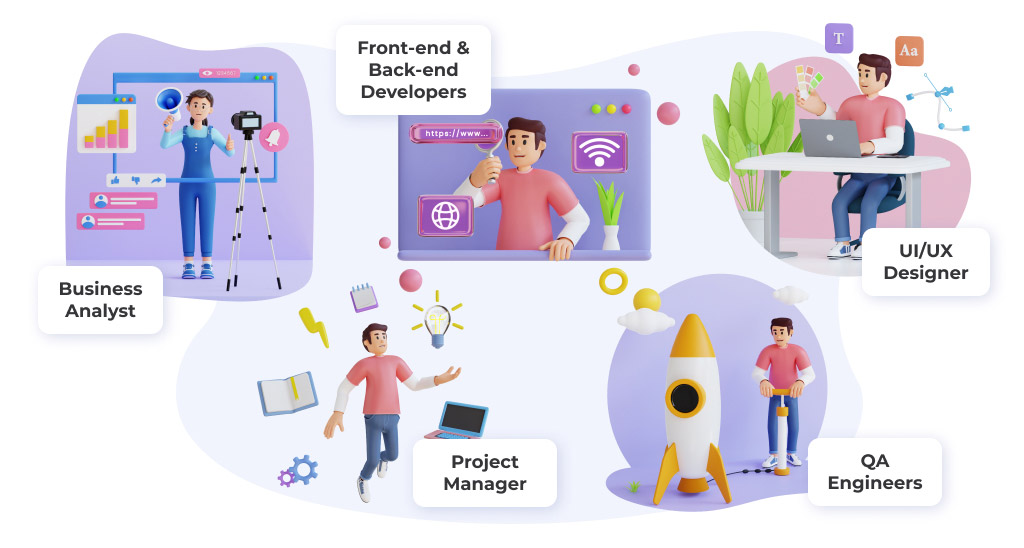
Looking for Hands-On Experience
When it comes to eHealth, there are various aspects and possibilities. Therefore, it is important for a company to have experience in healthcare app development in order to ensure successful collaboration. It is recommended to search for a team that has previous examples of pharma app development in their portfolio, rather than just focusing on EHR (Electronic Health Record) software or hospital management system development.
Inquire about the approach
After informing a professional team about your vision, you can inquire about the question. A reliable team possesses a structured framework that ensures smooth processes, enabling them to promptly offer you a preliminary plan.
As the communication progresses and the team gains a better understanding of the customer’s expectations, the plan becomes more comprehensive. However, it is crucial to establish a mutual understanding and initial strategy from the beginning.
Challenge them
There are many companies that offer custom online pharmacy app development services, but only a few are worth considering. To determine if a company is reliable or not, ask for their opinion on a challenging task that you need to address during the development process.
This could involve incorporating rare technology, improving the app’s performance, or resolving architectural issues. A professional team will view this challenge as an opportunity to innovate and provide multiple solutions. If they are unable to do so, it is best to find another team to trust with your project.
Check for availability of end-to-end development services
If you decide to divide the pharmacy app development tasks among different teams, it is advisable to select a tech team that can handle the entire development process. This will serve as a contingency plan in case any issues arise and the other contractor is unable to deliver.
Inquire if the vendor can provide all the necessary experts for developing an application, including a business analyst, project manager, front-end and back-end developers, UI/UX designer, and QA engineers. If they can, then you are ready to proceed.
Inquire about the documents
When investing in any digital product, it is important for the tech team to be prepared to sign all required documents and provide proof of their legal status. It is advisable to request certificates, contracts, and a non-disclosure agreement from the team. A trustworthy vendor will willingly share and sign the necessary paperwork.
Final Thoughts
Online pharmacy app development can be challenging and requires time, money, and attention to detail. To ensure success, it is important for the business owner to trust professionals who have experience in custom software development and knowledge of the healthcare industry.
STDIO ASIA is an experienced team that specializes in pharmacy app development and other healthcare software. They can handle all aspects of development, from market analysis to quality assurance, and deliver a custom solution tailored to your business needs. Contact STDIO ASIA now for more information or a free project estimation.

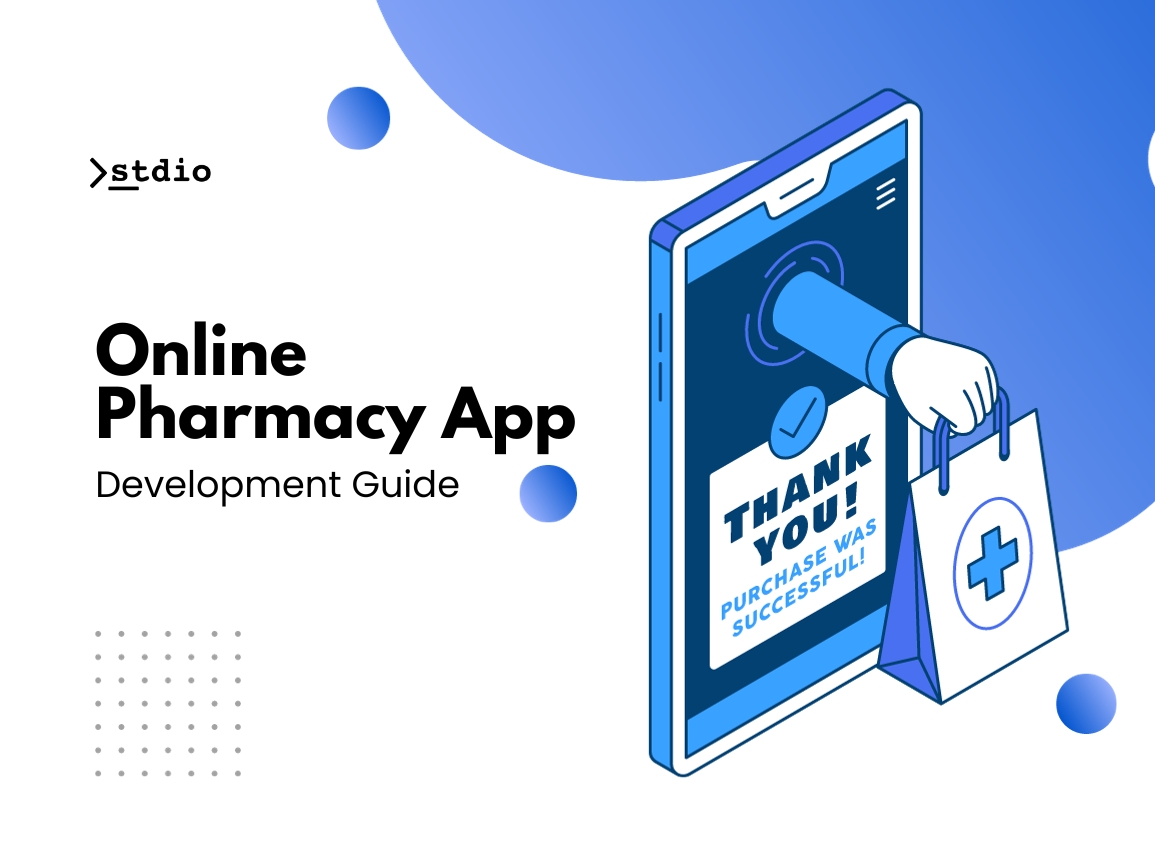

Leave a Reply